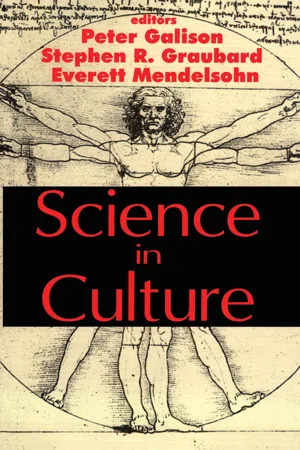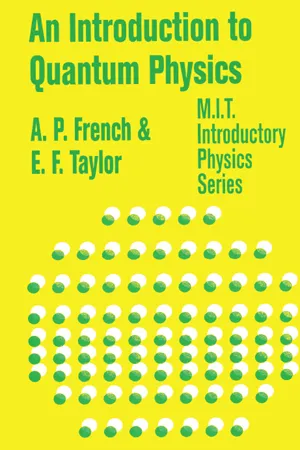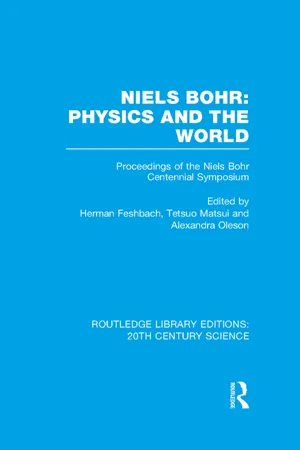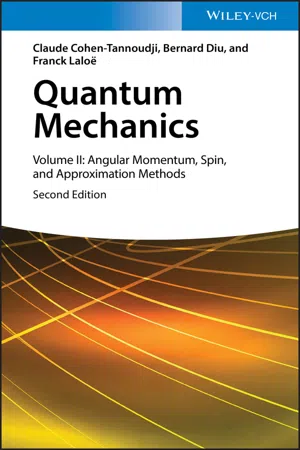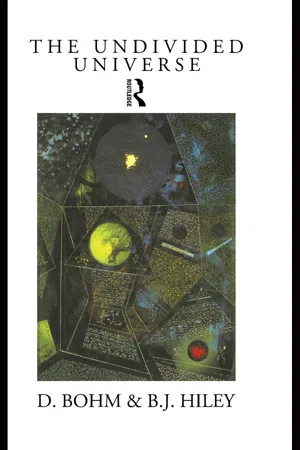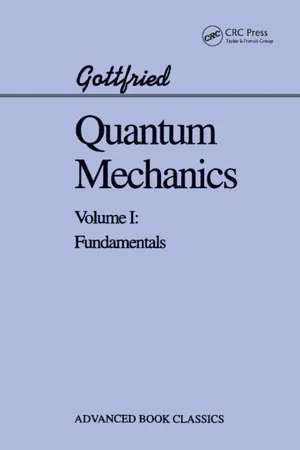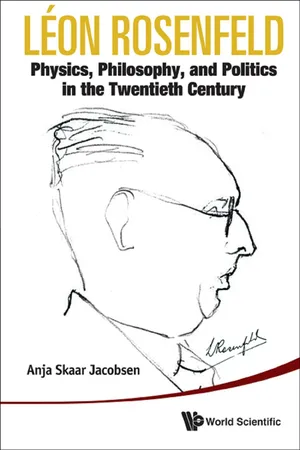Physics
Stern Gerlach Experiment
The Stern Gerlach experiment is a fundamental physics experiment that demonstrates the quantization of angular momentum. It involves passing a beam of particles through an inhomogeneous magnetic field, which causes the particles to be deflected in a way that reveals their intrinsic angular momentum, or spin, as being quantized in specific directions. This experiment provided crucial evidence for the existence of quantized spin states in particles.
Written by Perlego with AI-assistance
Related key terms
Related key terms
1 of 4
Related key terms
1 of 3
8 Key excerpts on "Stern Gerlach Experiment"
- eBook - ePub
Lectures on Quantum Mechanics
Volume 1: Basic Matters
- Berthold-Georg Englert(Author)
- 2006(Publication Date)
- WSPC(Publisher)
Chapter 2 Kinematics:How Quantum Systems are Described 2.1 Stern–Gerlach experimentNow turning to the systematic development of basic concepts and, at the same time, of essential pieces of the mathematical formalism, let us consider the historical Stern–Gerlach experiment of 1922 (Otto Stern and Walter Gerlach, that is). In a schematic description of this experiment,silver atoms are emerging from an oven (on the right), pass through collimating apertures, thereby forming a well defined beam of atoms, and then pass through an inhomogeneous magnetic field, eventually reaching a screen where they are collected. The inhomogeneous field is stronger at the top (z > 0 side) than the bottom (z < 0 side), which is perhaps best seen in a frontal view:Silver atoms are endowed with a permanent magnetic dipole moment so that there is a potential energyassociated with dipole in the magnetic field . It is smallest if and are parallel, largest when they are antiparallel:As a consequence, there is a torque on the dipole exerted by the magnetic field,that tends to turn the dipole parallel to . But since the intrinsic angular momentum, the spin, of the atom is proportional to , and the rate of change of the angular momentum is just the torque, we havewhich is to say that the dipole moment precesses around the direction of , whereby the value of Emagn remains unchanged,pictorially:In a homogeneous magnetic field this is all that would be happening, but the field of the Stern–Gerlach magnet is inhomogeneous, its strength depends on position, mainly growing with increasing z. Therefore, the magnetic energy is position dependent,and that gives rise to a force on the atom, given by the negative gradient of this magnetic energy,For · > 0, the force is toward the region of stronger field, for · - eBook - ePub
- Stephen R. Graubard(Author)
- 2018(Publication Date)
- Routledge(Publisher)
Both proponents and critics were stymied. Then, in 1921, Otto Stern proposed a definitive experiment, not involving spectroscopy. He asserted that “the experiment, if successful, will decide unequivocally between the quantum theoretical and classical views” and would thereby prove whether or not space quantization exists. 10 The Stern-Gerlach Experiment The immediate stimulus for Stern was a property implied by the Sommerfeld-Debye theory that had not been observed. According to the theory, as illustrated in figure 1, hydrogen atoms (with n = 1) in a magnetic field would be aligned such that the electron orbits are perpendicular to the direction of the field (m = ±1). A beam of light directed perpendicularly to the magnetic field would then interact differently with the orbiting electron, depending on whether the electric vector of the light oscillates parallel or perpendicular to the magnetic field. In the parallel case, the oscillating electric vector of the light acts to pull the electron out of its orbital plane; in the perpendicular case, it would displace the electron in the orbital plane. The propagation velocity of the light through a gas of hydrogen atoms, and hence the index of refraction, should therefore differ markedly for the parallel and perpendicular cases. As the same considerations apply for many-electron atoms or molecules, the old quantum theory predicted that any gas should be expected to exhibit birefringence, a phenomenon well known in optics of anisotropic liquid and solid media. However, magnetically induced birefringence of gases had never been observed. This cast yet another shadow on the old quantum theory but awakened in Stern an illuminating insight. As he recalled the creative moment: The question whether a gas might be magnetically biréfringent was raised at a seminar. The next morning I awoke early, too early to go to the lab - eBook - ePub
- A.P. French(Author)
- 2018(Publication Date)
- Routledge(Publisher)
z component of angular momentum, is indeed quantized.We have kept this discussion simple by naively modeling the magnetic atom in classical terms (except for the possibility of a discrete set of orientations). As we discuss the quantum-mechanical description of angular momentum in more detail, we shall retreat from the view of angular momentum vectors pointing in specific directions.10-3 STERN-GERLACH EXPERIMENT: DESCRIPTIVEWe pointed out earlier that the Stern-Gerlach experiment was performed with a beam of neutral silver atoms. Since it is very difficult to produce, steer, and detect a beam of neutral atoms, one might wonder why the quantization of angular momentum should not be explored with free electrons or charged atomic ions, which are easily produced and detected and may be focused and controlled by electric and magnetic fields. The main reason is that electric and magnetic forces on charged particles are typically so much larger than forces on atomic magnetic dipoles due to magnetic field gradients that the deflections we seek to study would be swamped by deflections due to electric charge (see the exercises). However, in the case of electrons there is also a general argument that proves the impossibility of splitting a beam into separate magnetic components.9Stern-Gerlach apparatusFigure 10-5a shows a schematic diagram of an atomic beam apparatus, and Figure 10-5b is a photograph of a modern apparatus used to demonstrate the Stern-Gerlach experiment.10 A basic requirement for atomic beam experiments is a good vacuum, since at atmospheric pressure atoms have free paths of only about 10~4 cm between collisions. By maintaining a low pressure of about 10−8 - eBook - ePub
- Herman Feshbach, Tetsuo Matsui, Alexandra Oleson(Authors)
- 2014(Publication Date)
- Routledge(Publisher)
Well then, could it not be that the source for some reason delivers particles with axes pointing just one way or the other and not in between? But this is easily tested by turning the Stern-Gerlach magnet. What we get (Fig. 6) is just the same split pattern as before, but turned around with the Stern-Gerlach magnet. To blame the absence of intermediate deflections on the source we would have to imagine that it anticipated somehow the orientation of the Stern-Gerlach magnet. Phenomena of this kind /3/ made physicists despair of finding any consistent space-time picture of what goes on the atomic and subatomic scale. Making a virtue of necessity, and influenced by positivistic and instrumentalist philosophies /4/, many came to hold not only that it is difficult to find a coherent picture but that it is wrong to look for one—if not actually immoral then certainly unprofessional. Going further still, some asserted that atomic and subatomic particles do not have any definite properties in advance of observation. There is nothing, that is to say, in the particles approaching the magnet, to distinguish those subsequently deflected up from those subsequently deflected down. Indeed even the particles are not really there. Figure 5. Quantum mechanical pattern on screen, with vertical Stern-Gerlach magnet. Figure 6. Quantum mechanical pattern with rotated Stern-Gerlach magnet. For example /5/, ‘Bohr once declared when asked whether the quantum mechanical algorithm could be considered as somehow mirroring an underlying quantum reality: “There is no quantum world. There is only an abstract quantum mechanical description. It is wrong to think that the task of physics is to find out how Nature is. Physics concerns what we can say about Nature”’. And for Heisenberg /6/ ‘… in the experiments about atomic events we have to do with things and facts, with phenomena that are just as real as any phenomena in daily life - eBook - ePub
Quantum Mechanics, Volume 2
Angular Momentum, Spin, and Approximation Methods
- Claude Cohen-Tannoudji, Bernard Diu, Franck Laloë(Authors)
- 2020(Publication Date)
- Wiley-VCH(Publisher)
A-1-c. Existence of half-integral angular momentaWe are confronted with the same difficulty in connection with the Stern-Gerlach experiment, which we described in Chapter IV (§ A-1); the beam of silver atoms is split symmetrically in two. These results suggest that half-integral values of j (which we saw in § C-2 of Chapter VI to be a priori possible) do indeed exist. But this poses a serious problem, since we showed in § D-1-b of Chapter VI that the orbital angular momentum of a particle such as an electron could only be integral (more precisely, it is the quantum number l which is integral). Even in atoms with several electrons, each of these has an integral orbital angular momentum, and we shall show in Chapter X that, under these conditions, the total orbital angular momentum of the atom is necessarily integral. The existence of half-integral angular momenta thus cannot be explained without supplementary hypotheses.Comment:It is not possible to measure directly the angular momentum of the electron using the Stern-Gerlach apparatus. Unlike silver atoms, electrons possess an electric charge q, and the force due to the interaction between their magnetic moment and the inhomogeneous magnetic field would be completely masked by the Lorentz force qv x B.A-2. Quantum description: postulates of the Pauli theory
indexSpin!quantum descriptionIn order to resolve the preceding difficulties, Uhlenbeck and Goudsmit (1925) proposed the following hypothesis: the electron “spins” and this gives it an intrinsic angular momentum which is called the spin. To interpret the experimental results described above, one must also assume that a magnetic moment MSis associated5 with this angular momentum S - eBook - ePub
The Undivided Universe
An Ontological Interpretation of Quantum Theory
- David Bohm, Basil J. Hiley(Authors)
- 2006(Publication Date)
- Routledge(Publisher)
In the BST model for the one-particle system there were additional quantum mechanical terms corresponding to explicit expressions for the spin-orbit coupling. But in the many-particle system, we could not find any acceptable physical interpretation for the vast number of terms that entered into the determination of the acceleration. In addition we found that we could not consistently attribute the spin angular momentum to an extended particle. We have therefore reached a point where the attempt to account for the acceleration in terms of various forces no longer provides any useful insight. Nevertheless the theory still works consistently as long as we have a suitable guidance condition.Given that there is no extended particle that is spinning and that what we call spin represents only some average property of the circulating orbital motion, how do we understand what we usually call a measurement of the spin, for example, in a Stern-Gerlach experiment? To discuss this, we may conveniently consider a neutral hydrogen atom with one orbital electron in an s-state. From equation (10.28 ) we can see that the operator for the interaction energy of the electron ‘spin’ with the magnetic field is (e/2m)σ.B. (We neglect nuclear spin here.) If B is inhomogeneous, that is B=B(z), it is readily shown [7 ] that this will cause the initial wave packet to break into two parts that move in opposite directions along the axis determined by B(0). For example, suppose the initial ‘spin’ was in the x-direction, so that the spin-current was circulating around the x-axis. After interaction with the inhomogeneous magnetic field in the z-direction, two packets begin to separate in this direction and eventually cease to overlap. Clearly the particle must end up in one of these packets. The results in each individual case depend, of course, on the precise initial conditions. The probability for each possible result will come out as one-half, given our assumptions about the probability distribution of the initial conditions. If the result corresponds to spin ħ/2, the current will circulate around the positive direction, while if the result is -ħ - eBook - ePub
Quantum Mechanics
Fundamentals
- Kurt Gottfried(Author)
- 2018(Publication Date)
- CRC Press(Publisher)
† we can easily evaluate the energy in the presence of the field becaseThe required energy eigenvalues are thereforeμ 0HL ∥Rn lY=l mμ 0H mRn lY.l mEn l m( R )=E−n l0μ 0m H( R ).(14) The degeneracy with respect to m has been lifted by the applied magnetic field; this is known as the Zeeman effect.19. The Stern-Gerlach ExperimentA beam of atoms (Ag in the original experiment) is passed through a magnet whose cross section is shown in Fig. 19.1 . Because of the inhomogeneous field, the atoms are subjected to the forceFig. 19.1. The Stern-Gerlach experiment.(cf. (18.12)), and the beams will be separated according to the spectrum of m values. By measuring the deflection μ0 m is determined.μ 0m ∂ H / ∂ ZAt early times atoms in the state m are described by the wave function u0 (Rt)Φm(r), where u0 is a free wave packet for the center-of-mass motion collimated as shown and moving towards the magnet system; Φ is now independent of R because the system is not in the field as yet. After the system is in the field, u0 (Rt)Φm(r) → um(Rt)Φm(r,R). For large values of t the wave function is um(Rt)Φm(r), where um(Rt) is nonzero in some spatial region Vm (t). These regions have the property that there is no overlap between Vm (t) and Vm′ (t) if m ≠ m′.Let u0 (Rt) be normalized to one. We assume that Φmis normalized:
hence∫rd 3Φ m ∗(r , R)Φm ′(=r , R)δ,mm ′(1) ∫Rd 3= 1.|2|u m(R t)(2) Consider as an initial wave packet on the left of H - eBook - ePub
Leon Rosenfeld: Physics, Philosophy, And Politics In The Twentieth Century
Physics, Philosophy, and Politics in the Twentieth Century
- Anja Skaar Jacobsen(Author)
- 2012(Publication Date)
- WSPC(Publisher)
68 His mathematical exposition of the so-called measurement problem in the same book has been taken as the starting point for all the later discussions on this topic (see epilogue).Thought experiments that particularly appealed to Bohr for elucidating the meaning of quantum mechanics were the double-slit experiment, Heisenberg’s gamma ray microscope experiment from the spring of 1927, and Einstein’s photon box experiment, discussed by Einstein and Bohr in 1930. The double-slit experiment demonstrates the inherent indeterminacy of quantum phenomena, Heisenberg’s uncertainty relation for position and momentum, the wave-particle duality, and the correlation between a quantum system and the measurement apparatus. The gamma ray microscope experiment was intended to make the wave-particle duality of light and matter and the uncertainty relation for position and momentum “anschaulich” (see Chapter 1 ). The photon box experiment was, in Bohr’s interpretation of it, about the use of a weighing mechanism for keeping track of the energy exchange between a photon and the measurement apparatus as well as measuring the exact energy of the photon. It was therefore meant as a challenge both to the quantum correlation between object and measurement apparatus and to Heisenberg’s uncertainty relation between energy and the time parameter of the photon. Bohr’s analysis of it, however, bringing in arguments based on Einstein’s own theory of general relativity, demonstrated the consistency of the quantum theory.Blackboard with Bohr’s drawings from a visit by Bohr to Japan 1937. Courtesy of The Niels Bohr Archive. Gamow’s Einstein box, a Christmas present to Bohr in 1930. The drawing of Einstein is made by Piet Hein. Courtesy of The Niels Bohr Archive.
Index pages curate the most relevant extracts from our library of academic textbooks. They’ve been created using an in-house natural language model (NLM), each adding context and meaning to key research topics.
Explore more topic indexes
Explore more topic indexes
1 of 6
Explore more topic indexes
1 of 4

